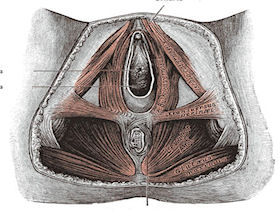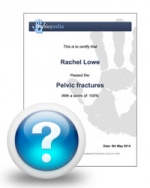Pelvic Floor Impact Questionnaire (PFIQ - 7): Difference between revisions
Kim Jackson (talk | contribs) No edit summary |
(Objective, method of use) |
||
| Line 9: | Line 9: | ||
[[Image:Pelvic floor.jpg|right]] | [[Image:Pelvic floor.jpg|right]] | ||
The PFIQ-7 is a shortened version of the | The Pelvic Floor Impact Questionnaire-7 (PFIQ-7) is a shortened, less comprehensive version of the Pelvic Floor Impact Questionnaire (PFIQ).<ref name="Barber">Barber MD, Walters MD, Bump RC. Short forms of two condition-specific quality-of-life questionnaires for women with pelvic floor disorders (PFDI-20 and PFIQ-7). American journal of obstetrics and gynecology. 2005 Jul 1;193(1):103-13.</ref> It was created by Barber and colleagues (2004)<ref name="Barber" /> to save time, yet remain effective, in clinical and research encounters. It is a health-related quality of life questionnaire that is specific for women with pelvic floor conditions.<ref name="Barber" /> It includes scales from the Urinary Impact Questionnaire (UIQ-7), Pelvic Organ Prolapse Impact Questionnaire (POPIQ-7), and the Colorectal-Anal Impact Questionnaire-7 (CRAIQ-7).<ref name="Barber" /> | ||
==Intended Population == | ==Intended Population == | ||
Women with | Women with pelvic floor conditions including [[Incontinence|urinary incontinence]], [[Pelvic Organ Prolapse|pelvic organ prolapse]], and fecal incontinence.<ref name="Barber" /> | ||
== Method of Use == | == Method of Use == | ||
The PFIQ-7 consists | The PFIQ-7 consists of 7 questions that need to be answered 3 times each (corresponds to the scales previously mentioned) considering symptoms related to the bladder or urine, vagina or pelvis, and bowel or rectum and their effect on function, social health, and mental health in the past 3 months. The responses for each question range from "not at all," which is a 0, to "quite a bit," which is a 4. The total for each of the 3 scales is configured. They are then added together, divided by 3, and then multiplied by 100 to get the PFIQ-7 score. | ||
== Evidence == | == Evidence == | ||
| Line 43: | Line 43: | ||
== Links == | == Links == | ||
[ | [https://www.sralab.org/sites/default/files/2017-06/Pelvic%20Floor%20Impact%20Questionnaire%20%28PFIQ-7%29.pdf Pelvic Floor Impact Questionnaire (PFIQ-7) on the Rehabilitation Measures Database] | ||
[http://www.womenshealthapta.org/wp-content/uploads/2013/12/PFDI-PFIQ.pdf Paper by Barber et al 2005 describing the development of the PFIQ-7] | [http://www.womenshealthapta.org/wp-content/uploads/2013/12/PFDI-PFIQ.pdf Paper by Barber et al 2005 describing the development of the PFIQ-7] | ||
| Line 69: | Line 69: | ||
[[Category:Outcome_Measures]] | [[Category:Outcome_Measures]] | ||
[[Category:Pelvic Health]] [[Category:Pelvis]] [[Category:Womens_Health]] [[Category:Pelvis]] [[Category:Pelvis - Outcome Measures]] | [[Category:Pelvic Health]] | ||
[[Category:Pelvis]] | |||
[[Category:Womens_Health]] | |||
[[Category:Pelvis]] | |||
[[Category:Pelvis - Outcome Measures]] | |||
Revision as of 04:38, 25 June 2020
Original Editor - Kirsten Ryan
Top Contributors - Kirsten Ryan, Admin, Michelle Walsh, Tony Lowe, Laura Ritchie, Kim Jackson, WikiSysop, Nicole Hills, Evan Thomas, Scott Buxton and Oyemi Sillo
Objective[edit | edit source]
The Pelvic Floor Impact Questionnaire-7 (PFIQ-7) is a shortened, less comprehensive version of the Pelvic Floor Impact Questionnaire (PFIQ).[1] It was created by Barber and colleagues (2004)[1] to save time, yet remain effective, in clinical and research encounters. It is a health-related quality of life questionnaire that is specific for women with pelvic floor conditions.[1] It includes scales from the Urinary Impact Questionnaire (UIQ-7), Pelvic Organ Prolapse Impact Questionnaire (POPIQ-7), and the Colorectal-Anal Impact Questionnaire-7 (CRAIQ-7).[1]
Intended Population[edit | edit source]
Women with pelvic floor conditions including urinary incontinence, pelvic organ prolapse, and fecal incontinence.[1]
Method of Use[edit | edit source]
The PFIQ-7 consists of 7 questions that need to be answered 3 times each (corresponds to the scales previously mentioned) considering symptoms related to the bladder or urine, vagina or pelvis, and bowel or rectum and their effect on function, social health, and mental health in the past 3 months. The responses for each question range from "not at all," which is a 0, to "quite a bit," which is a 4. The total for each of the 3 scales is configured. They are then added together, divided by 3, and then multiplied by 100 to get the PFIQ-7 score.
Evidence[edit | edit source]
Reliability[edit | edit source]
Each of the 3 scales (Urinary Impact Questionnaire, Pelvic Organ Prolapse Impact Questionnaire, and Colorectal-Anal Impact Questionnaire) correlates highly with their long forms (r = .96, r - .96, r = .94, respectively, P< .0001).[1]
Validity[edit | edit source]
The PFIQ-7 demonstrates construct validity as it demonstrates a significant association with appropriate measures of symptom severity and pelvic floor diagnoses.[1]
Responsiveness[edit | edit source]
The PFIQ-7 demonstrated moderate responsiveness with an effect size of .67 and a standardized response mean of .63. The ability of the PFIQ-7 to discriminate between subjects who indicated that they were "worse" after surgery from those who indicated they were "better" was excellent with c-statistic of .88[1]
Miscellaneous[edit | edit source]
The PFIQ-7 demonstrated a statistically significant improvement at 3 to 6 months after surgery, but the responsiveness was somewhat less than the PFDI-20.
One of the strengths of the PFIQ-7 is that it give a comprehensive assessment of the effect of pelvic floor disorders on the quality of life of women, rather than only assessing one aspect of pelvic floor function such as urinary incontinence. Its relative length makes it easy to use in both clinical and research settings.
Further studies are needed to determine the between-treatment MCID (clinically meaningful change in quality of life[2]) and the MCID of the individual scales.[1]
Links[edit | edit source]
Pelvic Floor Impact Questionnaire (PFIQ-7) on the Rehabilitation Measures Database
Paper by Barber et al 2005 describing the development of the PFIQ-7
Read 4 Credit[edit | edit source]
|
Would you like to earn certification to prove your knowledge on this topic? All you need to do is pass the quiz relating to this page in the Physiopedia member area. |
References[edit | edit source]
- ↑ 1.0 1.1 1.2 1.3 1.4 1.5 1.6 1.7 1.8 Barber MD, Walters MD, Bump RC. Short forms of two condition-specific quality-of-life questionnaires for women with pelvic floor disorders (PFDI-20 and PFIQ-7). American journal of obstetrics and gynecology. 2005 Jul 1;193(1):103-13.
- ↑ Crosby RD, Kolotkin RL, Rhys Williams G. Defining clinicallyfckLRmeaningful change in health-related quality of life. J ClinfckLREpidemiol 2003;56:395-407








